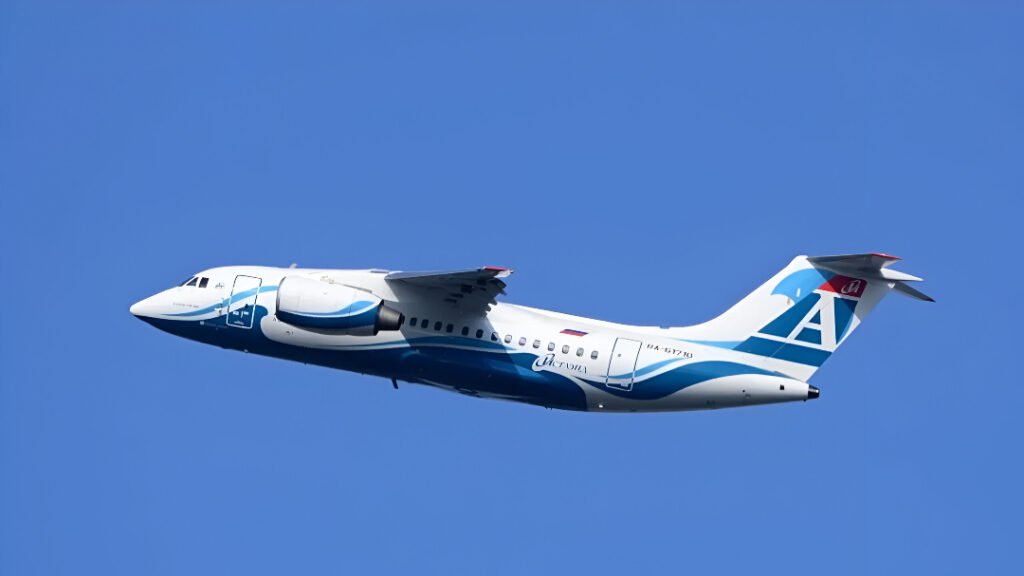
In a heartbreaking tragedy that has once again drawn attention to the perils of flying in remote regions, a Russian Antonov An-24 passenger plane crashed in the country’s far eastern Amur region on Thursday, July 24. All 48 people on board, including crew members, children, and a Chinese national, were confirmed dead. The crash occurred near the small town of Tynda, close to Russia’s border with China, in a region notorious for its tough terrain and erratic weather.
The aircraft, operated by Siberia-based airline Angara, lost contact with air traffic control while approaching Tynda. Emergency officials stated that the plane vanished from radar screens during its second landing attempt, amid poor visibility and difficult weather conditions.
Wreckage Discovered in Dense Forest
Following the crash, Russia’s Ministry of Civil Defence, Emergencies and Disaster Relief launched an extensive search and rescue operation. A Mi-8 helicopter from Rosaviatsiya (Russia’s civil aviation authority) eventually located the burning fuselage in a forest roughly 15 kilometers south of Tynda.
Images circulated by Russian state media revealed wreckage scattered through thick woods, with smoke rising from the crash site. Rescuers encountered serious difficulties reaching the site because of its location and the state of the terrain. The Amur region’s governor, Vasily Orlov, confirmed the fatalities and admitted that the rescue operation had been postponed by the region’s accessibility.
Witnesses and investigators also reported that the wreckage was “completely burned,” which complicated body identification and additional recovery efforts.
Older Aircraft Raises Safety Worry
The Antonov An-24 is a Cold War-era plane that took to the skies in the 1960s. The particular aircraft involved in this accident was almost 50 years old. While the model had been designed to endure tough weather and harsh climates, most are now outdated compared to contemporary air-travel standards. Yet, in Russia’s remote regions, where infrastructure is weak and options are few, such aircraft remain in frequent use.
This particular aircraft had departed from Khabarovsk, made a stop in Blagoveshchensk, and was en route to Tynda. Aviation experts believe that the crash may have been caused by a combination of harsh weather, poor visibility, and human error.
According to TASS, one investigative angle suggests that the crew misjudged conditions during the second landing attempt. The transport prosecutor’s office confirmed that communication was lost during this attempt and that the plane disappeared from radar shortly afterward.
Unfortunately, this tragedy isn’t an isolated case. In recent years, numerous crashes of old planes have been reported in Russia’s Far East and Arctic regions. Two Antonov An-26 plane crashes in 2021 claimed the lives of 34 people. The accidents have raised increasing concerns about the use of old planes in high-risk environments.
Remote Areas Depend on Hazardous Flights
Russia’s Far East is enormous, thinly populated, and frequently isolated from the rest of the nation. Aviation in such places is the only means of transport, communication, and emergency. With little infrastructure, too many flights rely on aging planes poorly suited for harsh weather.
While aviation safety has improved in Russia’s major cities and international corridors, regional air travel still struggles with poor modernization. A lack of investment, logistical difficulties, and limited government attention have resulted in a system that continues to rely on aging equipment.
Aides and air-safety authorities have continued to call for reforms phasing out aged planes, improved pilot training, and improved forecasting equipment for out-of-the-way routes. Budget constraints and administrative red tape have hindered progress. The Tynda crash is tragically reminiscent of the cost of phony delay.
Putin Briefed, Full Probe Launched

President Vladimir Putin was briefed on the accident immediately. A full-scale investigation has been launched to identify the precise cause of the crash. Officials are considering flight data, weather, maintenance records, and cockpit communications recordings.
Angara Airlines hasn’t released a comprehensive statement yet, but the air authorities are likely to scrutinize the company’s maintenance procedures and the service record of the plane. Results of the preliminary investigation should be out soon as officials try to determine what went wrong.
This tragedy is also likely to rekindle controversy about Russia’s air policy, most notably about the utilization of Soviet aircraft in unfriendly climates. Critics say unless stern action is taken, similar tragedies will continue to occur.
Nation Mourns, Questions Linger
As world efforts at rescue continue, Russia mourns the death of 48 people. To the families and communities it touched, particularly those in the remote Far East, the disaster is intimate. For community-oriented towns such as Tynda, where community flights connect lives and living, such a disaster has ripple effects across the whole region.
This accident isn’t simply a sad event; it’s a sour reminder of Russia’s imperative requirement for reform of its regional air transport system. It demands more attention to safety, money for modernization, and a sincerity to make sure not one life is lost due to antiquated infrastructure.
Until that time, the open Russian skies will be ominously unpredictable.









